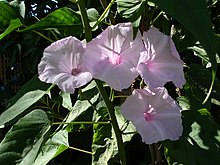Ipomoea
| Ipomoea | |
|---|---|
 |
|
| Ipomoea carnea, called canudo-de-pita in Brazil | |
| Scientific classification | |
| Kingdom: | Plantae |
| (unranked): | Angiosperms |
| (unranked): | Eudicots |
| (unranked): | Asterids |
| Order: | Solanales |
| Family: | Convolvulaceae |
| Tribe: | Ipomoeeae |
| Genus: |
Ipomoea L. 1753 |
| Species | |
|
More than 500, see text |
|
| Synonyms | |
|
Acmostemon Pilg. |
|
More than 500, see text
Acmostemon Pilg.
Batatas Choisy
Bonanox Raf.
Calonyction Choisy
Calycantherum Klotzsch
Diatremis Raf.
Dimerodisus Gagnep.
Exogonium Choisy
Mina Cerv.
Parasitipomoea Hayata
Pharbitis Choisy
Quamoclit Mill.
Quamoclit Moench
Ipomoea (/ˌɪpəˈmiːə, -poʊ-/) is the largest genus in the flowering plant family Convolvulaceae, with over 500 species. It is a large and diverse group with common names including morning glory, water convolvulus or kangkung, sweet potato, bindweed, moonflower, etc.
The most widespread common name is morning glories, but there are also species in related genera bearing the same common name. Those formerly separated in Calonyction (Greek καλός, kalos, good and νύκτα, nycta, night) are called moonflowers. The generic name is derived from the Greek words ιπς (ips) or ιπος (ipos), meaning "worm" or "bindweed," and όμοιος (homoios), meaning "resembling". It refers to their twining habit. The genus occurs throughout the tropical and subtropical regions of the world, and comprises annual and perennial herbaceous plants, lianas, shrubs and small trees; most of the species are twining climbing plants.
...
Wikipedia
